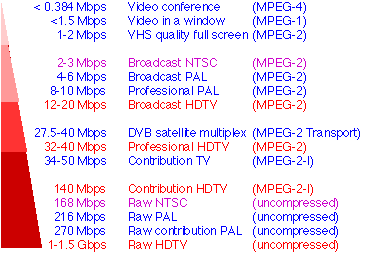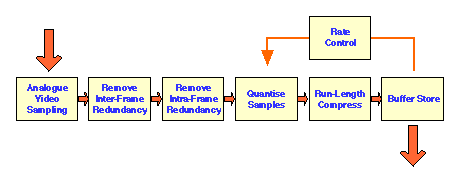
Summary of MPEG Compression Capability
MPEG is an encoding and compression system for digital multimedia content defined by the Motion Pictures Expert Group (MPEG). MPEG-2 extends the basic MPEG system to provide compression support for TV quality transmission of digital video. To understand why video compression is so important, one has to consider the vast bandwidth required to transmit uncompressed digital TV pictures.
Phase Alternate Line (PAL) is the analogue TV transmission standard used in the UK, and throughout many parts of the world. A uncompressed PAL TV picture requires a massive 216 Mbps, far beyond the capacity of most radio frequency links. The U.S. uses an analogue TV system called NTSC. This system provides less precise colour information, and a different frame rate. An uncompressed NTSC signal requires slightly less transmission capacity at 168 Mbps. The situation becomes much more acute, when one realises that high definition TV is just around the corner. A High Definition TV (HDTV) picture requires a raw bandwidth exceeding 1 Gbps (1000 Mbps).
MPEG-2 provides a way to compress this digital video signal to a manageable bit rate. The compression capability of MPEG-2 video compression is shown in the table below:

Summary of MPEG Compression Capability
Because the MPEG-2 standard provides good compression using standard algorithms, it has become the standard for digital TV. It has the following features:
The list of systems which now (or will soon) use MPEG-2 is extensive and continuously growing: digital TV (cable, satellite and terrestrial broadcast), Video on Demand, Digital Versatile Disc (DVD), personal computing, card payment, test and measurement, etc.
One of the potential new services which may be provided by MPEG-2 is the ability to use a return channel to allow the user to control the content or scheduling of the transmitted video / audio / data. This is known as interaction, and is seen by many as the key discriminator between traditional video and MPEG-2. MPEG-2 defines an interaction channel using DSM-CC.
Interaction channels may be used for diverse services including:
At the moment, nobody is quite sure whether, when everything falls into place, the bulk of users will interact through their TV s or their Personal Computers - and exactly how much interaction the users want or will pay for.
MPEG-2 is a standard from the Motion Pictures Expert Group (MPEG), which defines a series of standards for compression of moving picture information. The Moving Picture Coding Experts Group was established in January 1988 with the mandate to develop standards for coded representation of moving pictures, audio and their combination.
The following MPEG standards exist:
MPEG-1 and MPEG-2 have been standardised, whereas MPEG-4 and MPEG-7 are currently being developed. The MPEG-2 standard has been extended by various groups including:
The MPEG-2 video compression algorithm achieves very high rates of compression by exploiting the redundancy in video information. MPEG-2 removes both the temporal redundancy and spatial redundancy which are present in motion video.
Temporal redundancy arises when successive frames of video display images of the same scene. It is common for the content of the scene to remain fixed or to change only slightly between successive frames.
Spatial redundancy occurs because pats of the picture (called pels) are often replicated (with minor changes) within a single frame of video.

Clearly, it is not always possible to compress every frame of a video clip to the same extent - some parts of a clip may have low spatial redundancy (e.g. complex picture content), while other parts may have low temporal redundancy (e.g. fast moving sequences). The compressed video stream is therefore naturally of variable bit rate, where as transmission links frequently require fixed transmission rates. The key to controlling the transmission rate is to order the compressed data in a buffer in order of decreasing detail. Compression may be performed by selectively discarding some of the information. A minimal impact on overall picture quality can be achieved by throwing away the most detailed information, while preserving the less detailed picture content. This will ensure the overall bit rate is limited while suffering minimal impairment of picture quality.
The basic operation of the encoder is shown below:

Basic Operation of an MPEG-2 Encoder
MPEG-2 includes a wide range of compression mechanisms. An encoder must therefore which compression mechanisms are best suited to a particular scene / sequence of scenes. In general, the more sophisticated the encoder, the better it is at selecting the most appropriate compression mechanism, and therefore the higher the picture quality for a given transmission bit rate. MPEG-2 decoders also come in various types and have varying capabilities (including ability to handle high quality video, ability to cope with errors) and connection options.
A number of levels and profiles have been defined for MPEG-2 video compression. Each of these describes a useful subset of the total functionality offered by the MPEG-2 standards. An MPEG-2 system is usually developed for a certain set of profiles at a certain level. Basically:
The basic system is known as Main Profile Main Level (MP@ML) which covers video compression to 1-15 Mbps. There are other levels such as: High Level, High Level-1440, and Low Level; just as there are other profiles: Simple, SNR, Spatial, 4:2:2 and High.
Typical decoder specifications are:
Most decoders will also support MPEG-1:
The MPEG-2 standard defines an audio encoding scheme. Digital audio may be encoded in a number of other encoding formats at various bit rates.
MPEG-2 also provides support for data transmission. MPEG-2 differentiates two types of data:
See also :
